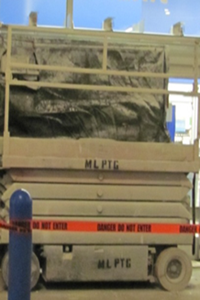Scissor lift platform rises pinning worker between guardrail and ceiling
Date of incident: January 2013
Notice of incident number: 2013124710035
Employer: Painting company
Incident summary
A painter was in a low-ceilinged area within a parkade, painting piping from the work platform of a scissor lift. In order to paint the underside of the pipes, the painter was leaning outside the top guardrail of the work platform while standing in front of and facing the control panel, which was mounted on the top rail of the work platform. As he was painting, the controller (joystick) became caught in his clothing. When he leaned forward, the controller was pushed forward, causing the platform to lift.
The painter's co-worker could not locate the emergency stop button because the mushroom-shaped cap identifying this control was missing. The painter was unable to disentangle himself before he was pinned between the guardrail and the ceiling. He died of his injuries.
Investigation conclusions
Causes
- Inadvertent movement of joystick after it caught in clothing, causing the scissor lift to elevate and then trap the painter between the guardrail and the ceiling: The painter was leaning outside the top guardrail of the work platform as he simultaneously leaned forward over the controller (joystick). The controller became caught in his clothing and fall protection harness. His forward movement inadvertently caused the controller to move forward, which in turn caused the work platform to elevate. He was crushed between the guardrail and the low ceiling.
Underlying factors
- Replaced and damaged switches and controls in a live position: At the time of the incident, three other switches were in a live position: the key switch, the Enable switch, and the Lift/Drive switch. The key was in the On position. The Enable switch was stuck and defective, causing it to be live without having to depress it. The Lift/Drive switch had replaced the original Lift/Off/Drive switch, forcing an operator to keep the switch in either Lift or Drive all of the time. The replaced and damaged control switches allowed the controller to be energized when workers would expect it not to be.
- Inadequate inspection and maintenance of equipment: The scissor lift involved in the incident was inadequately inspected by workers and inadequately inspected and maintained by its owner. It was not subject to a program of regular inspection and maintenance by a qualified person in order to maintain it in safe working condition.
- Equipment failed to meet requirements of the manufacturer and the applicable standard: The replaced controls had not been assessed by the manufacturer or a professional engineer to ensure that the equipment continued to meet the manufacturer's requirements and the appropriate CSA/ANSI standards.
- Workers were not adequately informed of the hazards: The painter and the co-worker did not recognize many hazards they were about to be exposed to. The supervisor was inadequately trained in hazard identification and control and failed to identify significant hazards. He did not discuss the hazards he did identify with the workers or ensure those hazards were addressed. Unidentified and unaddressed hazards allowed this incident to occur.
- Lack of a current operating procedure: The employer did not have a current operating procedure to address the various changes made to the control panel. Workers were not made aware of the changes to the controls and the impact of those changes to the operating procedure.
- Inadequate supervision: Failures of supervision were demonstrated at several levels. The supervisor did not report the known defect in the emergency stop button and did not conduct an adequate hazard assessment or discuss the hazards with workers. The employer did not supervise its workers adequately with respect to pre-use inspections of equipment. The employer did not conduct supplemental equipment inspections or ensure that site safety inspections were undertaken. The employer did not adequately oversee the activities of workers or provide adequate corporate oversight of safety activities.
- Inadequate training and instruction of workers: Workers were not adequately trained or instructed in conducting hazard assessments, completing effective pre-use inspections, or reporting defective equipment. They were not provided with safe operating instructions or with out-of-service criteria for equipment. Workers did not have adequate knowledge of the changes to the operating procedure that modifications and disrepair caused. Workers received a four-to-six-hour certification session from an external provider; the employer of the workers did not supplement this with additional training or instruction.

